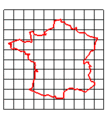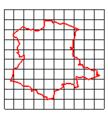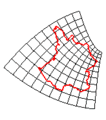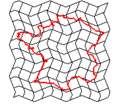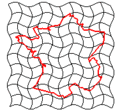Geometric transformation
수학(mathematics)에서, 기하학적 변환(geometric transformation)은 어떤 두드러진 기하학적 토대와 함께 하나의 집합(set)을 자신 (또는 또 다른 그런 집합)으로의 임의의 전단사(bijection)입니다. 더 구체적으로 말하면, 그것은 함수가 그것의 역함수(inverse)가 존재하도록 단사(injective)임을 만족하는 정의역과 치역이 점의 집합 — 가장 자주 둘 다 또는 둘 다 — 인 함수입니다.[1] 기하학(geometry) 연구는 이들 변형의 연구를 통해 접근할 수 있습니다.[2]
Classifications
기하학적 변환은 그것들의 피연산자 집합의 차원에 의해 분류될 수 있습니다 (따라서, 말하자면, 평면 변환과 공간 변환을 구별합니다). 그것들은 역시 그들이 보존하는 속성에 따라 분류될 수 있습니다:
- 변위(Displacements)는 거리(distances)와 방향화된 각도(oriented angles)를 보존합니다 (예를 들어, 평행이동(translations));[3]
- 등거리변환(Isometries)은 각도와 거리를 보존합니다 (예를 들어, 유클리드 변환(Euclidean transformations));[4][5]
- 닯음(Similarities)은 각도와 거리 사이의 비율을 보존합니다 (예를 들어, 크기-조정);[6]
- 아핀 변환(Affine transformations)은 평행성(parallelism)을 보존합니다 (예를 들어, 스케일링(scaling), 전단(shear));[5][7]
- 투영 변환(Projective transformations)은 공선형성(collinearity)을 보존합니다;[8]
이러한 각 클래스는 이전 클래스를 포함합니다.[8]
- 평면 (마찬가지로 원형 반전(circle inversion)) 위의 복소 좌표를 사용하는 뫼비우스 변환(Möbius transformations)은 모든 직선과 원의 집합을 보존하지만, 직선과 원을 교환-가능일 수 있습니다.
-
Original image (based on the map of France)
- 등각 변환(Conformal transformations)은 각도를 보존하고, 첫 번째 차수에서, 닮음입니다.
- 등가 변한(Equiareal transformations)은 평면 경우에서 넓이 또는 삼-차원 경우에서 부피를 보존하고,[9] 첫 번째 차수에서, 행렬식(determinant) 1의 아핀 변환입니다.
- 위상-동형(Homeomorphisms) (쌍-연속 변환(bicontinuous transformations))은 점의 이웃을 보존합니다.
- 미분-동형(Diffeomorphisms) (쌍-미분가능 변환(bidifferentiable transformations))은 첫 번째 차수에서 아핀인 변환입니다; 그것들은 특별한 경우로 앞의 것을 포함하고, 더 세분화될 수 있습니다.[10]
같은 유형의 변환은 다른 변환 그룹의 부분-그룹일 수 있는 그룹(groups)을 형성합니다.
Opposite group actions
많은 기하학적 변환이 선형 대수로 표현됩니다. 전단사 선형 변환은 일반 선형 그룹(general linear group)의 원소입니다. 선형 변환(linear transformation) A는 비-특이입니다. 행 벡터(row vector) v에 대해, 행렬 곱(matrix product) vA는 또 다른 행 벡터 w = vA를 제공합니다.
행 벡터 v의 전치(transpose)는 열 벡터 vT이고, 위 상등의 전치는 입니다. 여기서 AT는 열 벡터에 대한 왼쪽 동작을 제공합니다.
변형 기하학에서, 합성(compositions) AB가 있습니다. 행 벡터 v로 시작하여, 구성된 변환의 올바른 동작은 w = vAB입니다. 전치 후,
따라서 AB에 대해 결합된 왼쪽 그룹 동작(group action)은 입니다. 반대 그룹(opposite groups)의 연구에서, 이들 반대가 같은 그룹은 교환 그룹인 경우에만 반대 그룹 동작 사이에 구별이 이루어집니다.
See also
- Coordinate transformation
- Erlangen program
- Symmetry (geometry)
- Reflection
- Rigid transformation
- Rotation
- Topology
- Transformation matrix
References
- ^ Zalman Usiskin, Anthony L. Peressini, Elena Marchisotto – Mathematics for High School Teachers: An Advanced Perspective, page 84.
- ^ Venema, Gerard A. (2006), Foundations of Geometry, Pearson Prentice Hall, p. 285, ISBN 9780131437005
- ^ "Geometry Translation". www.mathsisfun.com. Retrieved 2020-05-02.
- ^ "Geometric Transformations — Euclidean Transformations". pages.mtu.edu. Retrieved 2020-05-02.
- ^ a b Geometric transformation, p. 131, at Google Books
- ^ "Transformations". www.mathsisfun.com. Retrieved 2020-05-02.
- ^ "Geometric Transformations — Affine Transformations". pages.mtu.edu. Retrieved 2020-05-02.
- ^ a b Leland Wilkinson, D. Wills, D. Rope, A. Norton, R. Dubbs – 'Geometric transformation, p. 182, at Google Books
- ^ Geometric transformation, p. 191, at Google Books Bruce E. Meserve – Fundamental Concepts of Geometry, page 191.]
- ^ stevecheng (2013-03-13). "first fundamental form" (PDF). planetmath.org. Retrieved 2014-10-01.
Further reading
- Adler, Irving (2012) [1966], A New Look at Geometry, Dover, ISBN 978-0-486-49851-5
- Dienes, Z. P.; Golding, E. W. (1967) . Geometry Through Transformations (3 vols.): Geometry of Distortion, Geometry of Congruence, and Groups and Coordinates. New York: Herder and Herder.
- David Gans – Transformations and geometries.
- Hilbert, David; Cohn-Vossen, Stephan (1952). Geometry and the Imagination (2nd ed.). Chelsea. ISBN 0-8284-1087-9.
- John McCleary – Geometry from a Differentiable Viewpoint.
- Modenov, P. S.; Parkhomenko, A. S. (1965) . Geometric Transformations (2 vols.): Euclidean and Affine Transformations, and Projective Transformations. New York: Academic Press.
- A. N. Pressley – Elementary Differential Geometry.
- Yaglom, I. M. (1962, 1968, 1973, 2009) . Geometric Transformations (4 vols.). Random House (I, II & III), MAA (I, II, III & IV).



